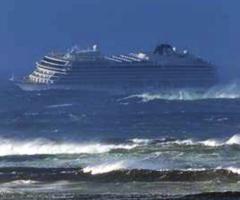 Last weekend, the cruise ship Viking Sky, with over 1,300 passengers and crew aboard, lost all four of its engines in high winds and rough seas off the Norwegian coast and came precariously close to drifting onto a rocky reef. Now the Norwegian Maritime Authority has concluded the engines’ failure “was directly caused by low oil pressure”. All four of the ship’s engines failed but the crew managed to restart one of them just in time.
Last weekend, the cruise ship Viking Sky, with over 1,300 passengers and crew aboard, lost all four of its engines in high winds and rough seas off the Norwegian coast and came precariously close to drifting onto a rocky reef. Now the Norwegian Maritime Authority has concluded the engines’ failure “was directly caused by low oil pressure”. All four of the ship’s engines failed but the crew managed to restart one of them just in time.
Whether the four diesel engines share a common lube oil system or whether each of the four engines was independently impacted by the rough seas is unclear.
The 47,800-tonne ship was travelling from Tromsø to Stavanger, carrying 915 guests and 458 crew, when the ship lost power near the notoriously rough waters of Hustadvika Bay.

The loss of oil pressure due to a large angle of heel was named as a likely cause of loss of power and ultimate sinking of the S/S EL FARO. Perhaps the classification societies should review the minimum allowable tank levels.
In fact, there was a mention that the low oil pressure alarms were not set either. To leave port knowing that you are low on oil albeit within the acceptable lower limit, seems like negligence. If indeed the alarms were not set that is tantamount to criminal negligence. I believe that those alarms are required on USCG inspected passenger carrying vessels, and that should be a requirement for other classifications as well, shouldn’t it?
I was actually guessing that the sludge in the bottom of the tanks had gotten so stirred up that they’d burned through the filters, but having the intake tubes out of contact with the oil and getting air bound — would that be what could have happened
The similarities to the two incidents are very disturbing. The two ships could hardly be more different but both apparently lost power sloshing of lube oil in extreme conditions. Fortunately, in the case of the Viking Sky, there were no fatalities but it was a very near thing.
Given the myriad similar cases of main engines losing lube oil due to rolling, one wonders about a lube oil standpipe (possibly combined with an air tank above it?) so as to bridge suction losses. A 60′ standpipe alone would provide ~23 psi when full– many large vessels could nearly double that figure. Combining that with a properly sized air tank above the standpipe could supply reasonable lube oil pressure at close to book values, long enough to
So that’s why this ship
nearly wrecked on
Norway’s rocks
NavyTimes.com – 1 day
ago
“”Sensors
detected the oil
shortage and
automatically shut
down the Viking
Sky’s engines to
prevent a
breakdown””
https://www.navytimes.com/news/your-navy/2019/03/29/so-thats-why-this-ship-nearly-wrecked-on-norways-rocks/